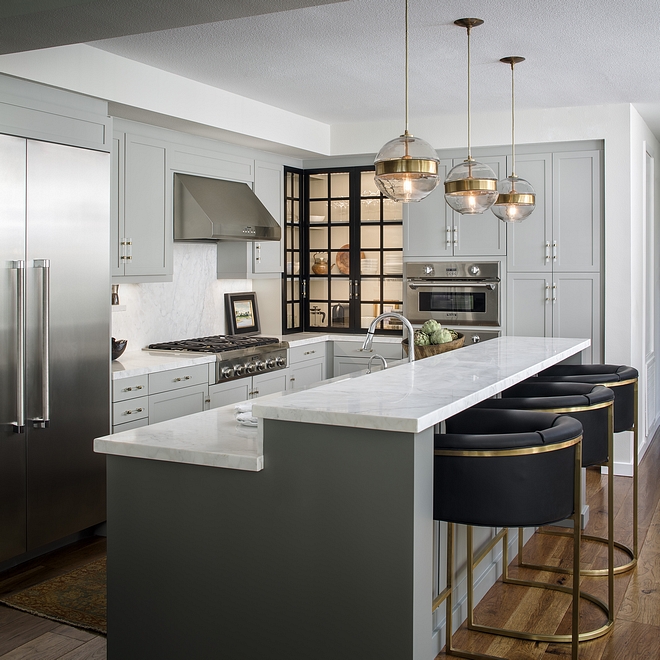The most common kitchen island height is 36 inches, matching standard countertop height. However, the ideal kitchen island height depends on how you plan to use it. This article will explore the standard kitchen island height, the optimal kitchen island height for different uses, and kitchen island height guidelines to help you determine the perfect height.

Image Source: www.clarkandaldine.com
Sizing Up Your Space: Kitchen Island Dimensions
Before diving into height, let’s consider overall kitchen island dimensions. Size matters! You need to ensure your island fits comfortably in your kitchen without creating a cramped space. Consider the following:
- Walkway Clearance: Aim for at least 36-42 inches of clearance around the island for comfortable movement.
- Island Length and Width: This depends on your kitchen size. Smaller kitchens might only accommodate a 4-foot long island, while larger kitchens can handle 8 feet or more. A width of 2-4 feet is typical.
- Shape: Islands can be rectangular, square, L-shaped, or even round. Choose a shape that complements your kitchen’s layout.
Factors Influencing Island Size
- Kitchen Size: The larger the kitchen, the larger the island can be.
- Workflow: Consider how you move around your kitchen and how the island will impact that flow.
- Appliances: If you plan to include a sink, cooktop, or dishwasher in your island, factor in the space requirements.
- Seating: The number of seats you want will affect the island’s length.
The Gold Standard: Standard Kitchen Island Height
The standard kitchen island height mirrors that of a typical kitchen counter: 36 inches. This height is comfortable for food preparation, chopping vegetables, and general kitchen tasks. It also aligns well with standard base cabinets, making construction easier. If you plan to use your island primarily for these activities, sticking with the standard kitchen island height is a safe bet.
Why 36 Inches?
- Ergonomics: It’s a comfortable height for most adults to work at without straining their backs.
- Cabinet Compatibility: Matches the height of standard base cabinets.
- Resale Value: Conforms to expectations for potential buyers.
Counter Intelligence: Countertop Height for Kitchen Island
The term countertop height for kitchen island typically refers to the standard 36-inch height discussed above. However, keep in mind that this is just one option. Let’s explore others.
Pull Up A Chair: Height for Kitchen Island with Seating
If you plan to use your kitchen island with seating, you have two main options: counter height and bar height. The optimal kitchen island height depends on the type of seating you prefer.
Counter Height Seating (36 inches)
- Chair Height: Requires counter-height stools, typically 24-26 inches high.
- Pros: Comfortable for casual meals, allows for easy conversation with those standing at the island.
- Cons: May not be ideal for those who prefer a higher seating position.
Bar Height Seating (42 inches)
- Chair Height: Requires bar-height stools, typically 30 inches high.
- Pros: Creates a more defined separation between the kitchen and living areas, offers a more elevated dining experience.
- Cons: Can be less comfortable for extended periods, may not be suitable for young children or those with mobility issues.
Two-Tiered Islands: A Height of Distinction
A two-tiered island offers the best of both worlds. One level can be the standard 36 inches for food preparation, while the other is raised to 42 inches for bar-height seating. This design provides visual interest and functional versatility.
Considerations for Two-Tiered Islands:
- Space Requirements: Two-tiered islands require more space than single-level islands.
- Aesthetics: Ensure the design complements your kitchen’s overall style.
- Functionality: Consider how you will use each tier and design accordingly.
Finding Your Fit: Optimal Kitchen Island Height
The optimal kitchen island height hinges on individual needs and preferences.
- Tall Individuals: A slightly higher island (38-40 inches) may be more comfortable.
- Shorter Individuals: A lower island (34-36 inches) might be a better choice.
- Accessibility Needs: Consider a lower island section (30-34 inches) for wheelchair accessibility.
- Specific Tasks: If you plan to use your island primarily for baking, a slightly lower height might be beneficial for kneading dough.
Personalize Your Island: Height Customization
Don’t be afraid to customize the average kitchen island height to fit your specific needs. A good carpenter can create a custom island with a height that’s perfect for you.
Height Matters: Ergonomics and Functionality
Choosing the right height for kitchen island with seating is crucial for both comfort and functionality. An island that’s too high or too low can lead to back pain, neck strain, and discomfort.
Ergonomic Considerations
- Elbow Height: When standing at the island, your elbows should be bent at a comfortable 90-degree angle.
- Chair Height: When seated, your thighs should be parallel to the floor and your feet should rest comfortably on the floor or a footrest.
- Reach: Ensure you can easily reach all areas of the countertop without straining.
Functional Considerations
- Task Lighting: Install appropriate task lighting to illuminate the work surface.
- Outlets: Include plenty of electrical outlets for appliances and charging devices.
- Storage: Maximize storage space with drawers, shelves, and cabinets.
The Blueprint: Kitchen Island Height Guidelines
Here’s a summary of kitchen island height guidelines to assist your decision-making process:
- Standard Height: 36 inches (matches standard countertops).
- Counter Height Seating: 36 inches (use 24-26 inch stools).
- Bar Height Seating: 42 inches (use 30-inch stools).
- Two-Tiered Islands: Combine 36-inch and 42-inch heights.
- Customization: Adjust height based on individual needs and preferences.
A Table for Quick Reference
| Island Type | Height (Inches) | Stool Height (Inches) | Primary Use |
|---|---|---|---|
| Standard/Countertop | 36 | 24-26 | Food preparation, casual dining |
| Bar Height | 42 | 30 | Elevated dining, social gathering |
| Two-Tiered | 36 & 42 | 24-26 & 30 | Multi-purpose, visual interest |
| Accessible (Custom) | 30-34 | N/A (Wheelchair) | Wheelchair accessibility |
Is Higher Always Better?: Bar Height Kitchen Island
A bar height kitchen island (42 inches) offers a more casual and social atmosphere. It’s great for entertaining and creating a visual barrier between the kitchen and living areas. However, it may not be the best choice for families with young children or individuals with mobility issues.
Benefits of a Bar Height Island:
- Visual Appeal: Adds a modern and stylish touch to your kitchen.
- Social Hub: Creates a welcoming space for gathering and conversation.
- Hides Mess: A higher countertop can conceal clutter.
Drawbacks of a Bar Height Island:
- Less Comfortable: Can be less comfortable for extended periods.
- Accessibility Issues: May not be suitable for everyone.
- Stool Cost: Bar-height stools tend to be more expensive than counter-height stools.
Putting It All Together: Planning Your Island
- Measure Your Space: Accurately measure your kitchen to determine the maximum island size.
- Consider Your Needs: Think about how you will use the island and choose a height that suits your needs.
- Choose Your Seating: Select stools that are comfortable and stylish.
- Plan for Storage: Maximize storage space with drawers, shelves, and cabinets.
- Hire a Professional: If you’re unsure about any aspect of the design or construction, consult with a qualified kitchen designer or contractor.
Frequently Asked Questions (FAQ)
What is the standard overhang for a kitchen island countertop?
The standard overhang for a kitchen island countertop is typically 12-15 inches to allow comfortable legroom for seating.
Can I have different heights on the same island?
Yes, a two-tiered island allows for different heights, typically 36 inches and 42 inches, to accommodate both food preparation and seating.
Who can help me design my kitchen island?
A kitchen designer or contractor can help you design your kitchen island to meet your specific needs and preferences.
What is the best material for a kitchen island countertop?
Common countertop materials include granite, quartz, marble, butcher block, and stainless steel. The best choice depends on your budget, style, and durability requirements.
What if my kitchen is small? Can I still have an island?
Yes, even small kitchens can accommodate a small island or kitchen cart. Consider a rolling island for added flexibility.

Hi, I’m Larry Fish, the mind behind MyGrinderGuide.com.. With a passion for all things kitchen appliances, I created this blog to share my hands-on experience and expert knowledge. Whether it’s helping you choose the right tools for your culinary adventures or offering tips to make your kitchen more efficient, I’m here to guide you. My goal is to make your time in the kitchen not only easier but also enjoyable! Welcome to my world of kitchen mastery!
